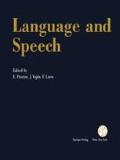Summary
The neurophysiological and the neurolinguistic basis of multilingualism is not yet fully elucidated. A study of the occurrence of aphasia in multilingual patients and the pattern of recovery may help to clarify some unsolved problems. For e.g. is the ability to use a second language stored in a different area of the left hemisphere and what is the extent of involvement of the right hemisphere in language skills? When recovery from aphasia occurs, what factors determine the rate of recovery of different languages and the priorities of recovery?
To understand some of the problems, a study of aphasia in multilinguals was conducted in Madras, South India, where multilingualism is common. 88 patients were studied with 40 healthy controls, using standard protocols. It was found that the pattern of recovery was dispersed widely in time, rate, level, degree and between the languages known. No support was obtained for the notion that the patients’ mother tongue recovers first, nor was support found for the importance of language proficiency viewed globally. Evidence was found that the languages in which routine thinking, mental calculations and praying were carried out were the ones most resistant to damage in brain insults. It is interesting that these functions are all highly overlearned, acquired early in life and used frequently over the course of many years.
Another observation made was that the incidence of crossed aphasia was fairly high, in both uni- and multi-linguals, with the latter showing a slightly higher incidence. The more than expected higher incidence of crossed aphasia in unilinguals suggests that the language capacities of the right hemisphere in unilinguals may have been underestimated in earlier literature.
There are many aspects of language function in multilingual aphasics which have to be elucidated and further extensive neurolinguistic research is necessary, before positive conclusions can be arrived at.
Access this chapter
Tax calculation will be finalised at checkout
Purchases are for personal use only
Preview
Unable to display preview. Download preview PDF.
References
Albert M, Obler L (1978) The bilingual brain. Academic Press, New York
Chary P (1980) Speech disorders in South Indians. Doctoral dissertation, University of Madras
Chary P (1986) Aphasia in a multilingual society. In: Vaid J (ed) Language processing in bilinguals; psycholinguistic and neuro-psychological perspectives. Lawrence Erlbaum Ass., London, pp 183–197
Critchley M (1962) Speech and speech loss hi relation to the duality of the brain. In: Mount Castle UB (ed) Interhemispheric relations and cerebral dominance. Johns Hopkins Univ Press, Baltimore
Ervin S, Osgood C (1954) Second language learning and bilingualism. J Abnorm Soc Psychol 49: 139–146
Gal S (1978) Variation and change in patterns of speaking: Language shifts in Austria. In: Sankoff D (ed) Linguistic variation. Academic Press, New York
Galloway L (1981) Contribution of the right cerebral hemisphere to language and communication. Unpublished doctoral dissertation, University of California, Los Angeles
Gloning I, Gloning K (1965) Aphasien bei Polyglotten. Beitrag zur Dynamik des Sprachabbaus sowie zur Lokalisationsfrage dieser Störungen. Wien Z. Nervenheilk 22: 362–397
Graziel T, Obler L, Bentin S, Albert M (1977) The dynamics of lateralization in second language learning: Sex and proficiency effects. Paper read at Boston University Conference on Language Development, Boston, Mass
Gumperz J (1976) The sociolinguistic significance of conversational code-switching. Working papers of the Language Behavior Research Laboratory, #46. University of California, Berkeley
Hummel KM (1986) Memory for bilingual prose. In: Vaid J (ed) Language processing in bilinguals. Psycholinguistic and neuro-psychological perspectives. L.E.A. Publishers, London
Lecours AR, Lhermittef, Bryans (1983) Aphasia in bilinguals and polyglots. In: Lecours AR, Lhermitte F, Bryans B (eds) Aphasiology. Baillere Tindall, London, pp 455–464
Minkowski M (1928) Sur un cas d’aphasie chez un polyglotte. Rev Neurol (Paris) 1: 36
Nair K, Virmani V (1973) Speech and language disturbances in hemiplegics. Indian J Med Res 61: 1395–1403
Obler LK, Albert M, Gordon H (1975) Asymmetry of cerebral dominance in Hebrew-English bilinguals. Paper read at Thirteenth Annual Meeting of the Academy of Aphasia, Victoria, Canada
Paradis M (1977) Bilingualism and aphasia. In: Whitaker H, Whitaker HA (eds) Studies in neurolinguistics, Vol 3. Academic Press, New York, pp 65
Paradis M (1983) Readings on aphasia in bilinguals and polyglots. Didier, Montreal
Pitres A (1895) Etude sur l’aphasie chez les polyglottes. Rev Med 15: 873–899
Ribot T (1881) Diseases of memory: An e ssay in the positive psychology. Paul, London
Segalowitz SJ (1979) Infant cerebral asymmetries and developmental models of brain lateralization. Paper read at the 40th Annual Meeting of the Canadian Psychological Association, Quebec, Canada
Segalowitz SJ (1983) Cerebral asymmetries for speech in infancy. In: Segalowitz SJ (ed) Language functions and brain organization Academic Press, New York, pp 221–229
Sridhar SN (1978) On the functions of code-mixing in Canada. Int J Soc Lang 16: 109–118
Sridhar S, Sridhar K (1980) The syntax and psycholinguistics of bilingual code-mixing. Can J Psychol 34: 407–416
Vaid J (1986) Language processing in bilinguals. Psycholinguistic and neuropsychological perspectives. L.E.A. Publishers, London
Wulfeck BB et al. (1986) Sentence interpretation strategies in health and aphasic bilingual adults. In: Vaid J (ed) Language processing in bilinguals. Psycholinguistic and neuropsychological perspectives. L.E.A. Publishers, London, pp 199–219
Author information
Authors and Affiliations
Editor information
Editors and Affiliations
Rights and permissions
Copyright information
© 1993 Springer-Verlag
About this paper
Cite this paper
Ramamurthi, B., Chari, P. (1993). Aphasia in Bilinguals. In: Pásztor, E., Vajda, J., Loew, F. (eds) Language and Speech. Acta Neurochirurgica Supplementum, vol 56. Springer, Vienna. https://doi.org/10.1007/978-3-7091-9239-9_10
Download citation
DOI: https://doi.org/10.1007/978-3-7091-9239-9_10
Publisher Name: Springer, Vienna
Print ISBN: 978-3-7091-9241-2
Online ISBN: 978-3-7091-9239-9
eBook Packages: Springer Book Archive

